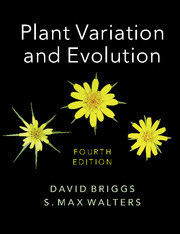Book contents
- Frontmatter
- Contents
- Preface to the Fourth Edition
- Acknowledgements
- Note on names of plants
- List of abbreviations
- 1 Investigating plant variation and evolution
- 2 From Ray to Darwin
- 3 Early work on biometry
- 4 Early work on the basis of individual variation
- 5 Post-Darwinian ideas about evolution
- 6 DNA: towards an understanding of heredity and molecular evolution
- 7 Breeding systems
- 8 Intraspecific variation and the ecotype concept
- 9 Pattern and process in plant populations
- 10 Pattern and process: factors interacting with natural selection
- 11 Populations: origins and extinctions
- 12 Species and speciation: concepts and models
- 13 Allopatric speciation and hybridisation
- 14 Abrupt speciation
- 15 The species concept
- 16 Flowering plant evolution: advances, challenges and prospects
- 17 Historical biogeography
- 18 The evolutionary impact of human activities
- 19 The taxonomic challenge ahead
- 20 Conservation: from protection to restoration and beyond
- Glossary
- References
- Index
12 - Species and speciation: concepts and models
Published online by Cambridge University Press: 05 June 2016
- Frontmatter
- Contents
- Preface to the Fourth Edition
- Acknowledgements
- Note on names of plants
- List of abbreviations
- 1 Investigating plant variation and evolution
- 2 From Ray to Darwin
- 3 Early work on biometry
- 4 Early work on the basis of individual variation
- 5 Post-Darwinian ideas about evolution
- 6 DNA: towards an understanding of heredity and molecular evolution
- 7 Breeding systems
- 8 Intraspecific variation and the ecotype concept
- 9 Pattern and process in plant populations
- 10 Pattern and process: factors interacting with natural selection
- 11 Populations: origins and extinctions
- 12 Species and speciation: concepts and models
- 13 Allopatric speciation and hybridisation
- 14 Abrupt speciation
- 15 The species concept
- 16 Flowering plant evolution: advances, challenges and prospects
- 17 Historical biogeography
- 18 The evolutionary impact of human activities
- 19 The taxonomic challenge ahead
- 20 Conservation: from protection to restoration and beyond
- Glossary
- References
- Index
Summary
Since the time of John Ray, whose own attempt at a definition of species we discussed in Chapter 2, there has been no universally agreed definition of ‘species’; different definitions have been devised by biologists working in different specialist fields. Thus, the word ‘species’ has different meanings for different biologists. Here, we examine five influential definitions that focus on different aspects of pattern and process in evolution. (For thorough reviews of species concepts, see Stuessy, 2009; Wilkins, 2009).
The morphological species concept
Historically, the naming, description and classification of species have been based largely upon morphological details of herbarium specimens, and to a lesser extent living material collected from wild or cultivated sources. This is supplemented by geographical and sometimes ecological information. The aim of the taxonomist is to provide a convenient general-purpose classification of the material, a classification that will serve the needs of biologists in diverse fields.
It is quite obvious that in order to communicate experimental findings to others, by word of mouth, in the literature and through databases, the experimentalist, like any other botanist, must be able to name plants unambiguously. To this end, an International Code of Botanical Nomenclature has been agreed. The development of this Code has a fascinating history (Smith, 1957). By 1900, four rival codes of practice were employed in different herbaria. Discussions of the problem occupied taxonomic sessions at International Botanical Congresses in Vienna (1905), Cambridge (1930) and Amsterdam (1935), and the successive Congresses, now at approximately 5-yearly intervals, are the occasion for continued revision of the Code. The international agreements leading to a unified Code must be recognised as a major achievement.
One meaning of the word ‘species’ is now clarified. We may say that species are convenient classificatory units defined by trained biologists using all the information available. Clearly there is a subjective element in their work, and we must therefore face the fact that there will sometimes be disagreements between taxonomists about the delimitation of particular species, but there is a very large measure of agreement, for all except ‘critical groups’, in regions where the flora has been studied for many years. In the taxonomic process, a type specimen is designated and a diagnosis provided that specifies the important distinguishing characteristics of the ‘new’ species from others of the same group (Stace, 1980; Stuessy, 1990, 2009).
- Type
- Chapter
- Information
- Plant Variation and Evolution , pp. 242 - 249Publisher: Cambridge University PressPrint publication year: 2016



